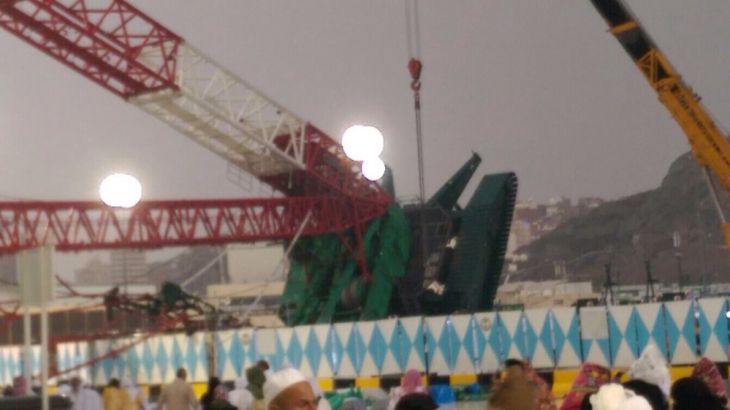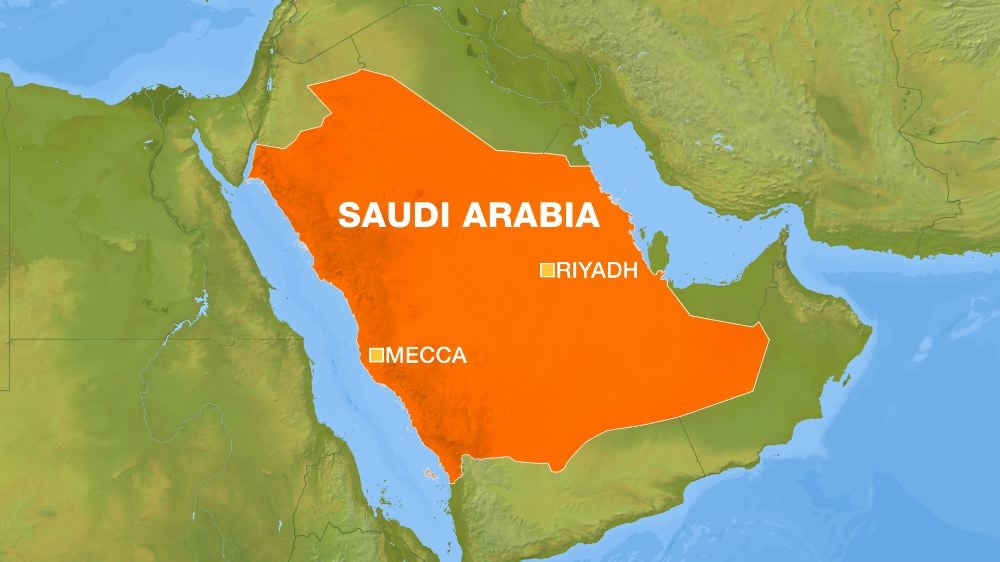Saudis probe deadly Mecca crane collapse
The accident during storm killed at least 107 people and wounded more than 200 others at Grand Mosque.

Saudi authorities are investigating a construction crane collapse that killed at least 107 people and wounded 238 others during a storm at Mecca’s Grand Mosque, pledging that the annual hajj pilgrimage would go ahead.
As world leaders offered condolences, the governor of Mecca region, Prince Khaled al-Faisal, ordered an investigation into the tragic accident that occurred as worshipers gathered for prayers.
Keep reading
list of 4 itemsMuslim pupil loses UK court bid over Michaela school prayer rituals ban
Photos: Sikhs celebrate harvest festival of Baisakhi, marking new year
Masses gather for Eid celebrations in India
King Salman inspected the site of the collapse, and then visited the injured in Al-Nour Hospital, promising that he would personally oversee the probe.
The Saudi Press Agency quoted a spokesperson for the two holy mosques as saying that the crane was brought down by strong wind and heavy rain.
Abdel Aziz Naqoor, who said he works at the mosque, told the AFP news agency that he saw the massive construction crane fall after being hit by the storm.
“If it weren’t for Al-Tawaf bridge the injuries and deaths would have been worse,” he said, referring to a covered walkway that surrounds the holy Kaaba, which broke the crane’s fall.
General Suleiman al-Amr, director-general of the Civil Defence Authority, told Al Ikhbariya television that strong wind and rains had uprooted trees and rocked cranes in the area.
Irfan al-Alawi, co-founder of the Mecca-based Islamic Heritage Research Foundation, suggested that authorities were negligent by having a series of cranes overlooking the mosque.
Pictures circulating on social media showed pilgrims in bloodied robes and debris from a part of the crane that appeared to have crashed through a ceiling.
https://twitter.com/Hasanpatel/status/642484568579137536
Other pictures showed queues of Saudi men volunteering to donate blood for the injured.
A Saudi official said this year’s hajj would proceed despite the tragedy.
Official statement
A statement by a spokesperson for the administration of the mosques in Mecca and Medina said the crane toppled in the part of the Grand Mosque where worshippers circle the Kaaba – the black-clad cube towards which the world’s 1.6 billion Muslims face to pray.
Al Jazeera’s Hasan Patel, reporting from Mecca, said witnesses told him that the crane fell on the third floor of the Grand Mosque at around 5.30pm on Friday.
![In addition to the fatalities, 238 people were wounded in Friday's crane accident in the Grand Mosque, Saudi officials said [AP]](/wp-content/uploads/2015/09/a12a20d4207e421aa230e054e8bb0137_18.jpeg)
“Dozens of ambulances headed to the site. The authorities closed off the area shortly afterwards,” he said.
“This whole place is already a giant construction site. What made it worse is that around 5.30pm there was severe rain and it was just gushing down the road.
“I am surrounded by people who are grieving. The mood here is of sadness.”
Saudi authorities go to great lengths to prepare for the millions of Muslims who converge on Mecca to perform the sacred pilgrimage.
Last year, they reduced the numbers permitted to make the Hajj pilgrimage on safety grounds because of
construction work to enlarge the Grand Mosque.
Prone to disasters
The Hajj, one of the largest religious gatherings in the world, has been prone to disasters in the past, mainly from stampedes as pilgrims rush to complete rituals and return home.
Hundreds of pilgrims died in such a crush in 2006.
Saudi authorities have since spent vast sums to expand the main Hajj sites and improve Mecca’s transport system, in an effort to prevent more disasters.
https://twitter.com/Hasanpatel/status/642436542175117313
Security services often ring Islam’s sacred city with checkpoints and other measures to prevent people arriving for the pilgrimage without authorisation.
Those procedures, aimed at reducing crowd pressure which can lead to stampedes, fires and other hazards, have been intensified in recent years as security threats grow throughout the Middle East.
Richard Angwin, Al Jazeera’s senior weather presenter, said the autumn period is when half of Mecca’s thunderstorms occur, so “it was no great surprise that there were thunderstorms in the area”.
“The area of low pressure which brought sandstorms across the Levant region moved further south, allowing hot, moist air to develop into thunderstorms along the mountains bordering the Red Sea, and some of those drifted northwards across Mecca,” he said.
